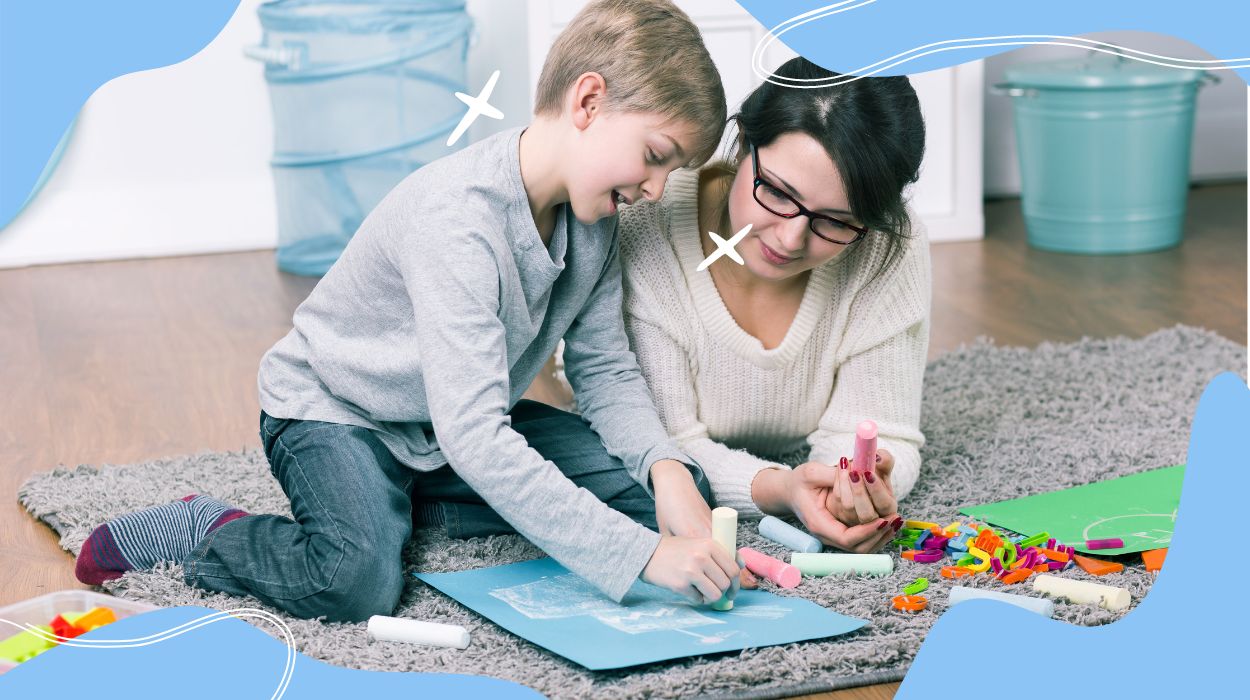 Expert's opinion
Expert's opinion
Expert's opinion
The article is a subjective view on this topic written by writers specializing in medical writing.
It may reflect on a personal journey surrounding struggles with an illness or medical condition, involve product comparisons, diet considerations, or other health-related opinions.
Although the view is entirely that of the writer, it is based on academic experiences and scientific research they have conducted; it is fact-checked by a team of degreed medical experts, and validated by sources attached to the article.
The numbers in parenthesis (1,2,3) will take you to clickable links to related scientific papers.
Autism Therapy At Home You Can Practice With Your Child 2024

Autism impacts millions of children worldwide. And, because autistic persons spend most of their time at home, it seems natural to seek alternative treatments for autism to alleviate some of the condition’s symptoms.
If you are having a hard time at home with your child living with autism, this comprehensive guide explores a range of at-home therapies. These include parent-child interactions, speech therapy, and occupational therapy sessions.
You’ll also learn how play therapy can positively impact your child’s progress and how to create the most supportive home and family environment possible. Ultimately, you’ll learn how to use autism therapy at home to unlock your child’s potential.
Autism Therapies That Parents Can Provide In Their Own Home
Parents can provide the following autism therapies in their own home:
- Parent-child interaction therapy.
- Speech therapy.
- Occupational therapy.
- Play therapy.
- Applied behavior analysis therapy.
- Creating a supportive home environment.
By incorporating these therapies at home, you can support your child’s development, enhance communication skills, and promote a positive and nurturing environment for your child with autism.
Autism Therapies At Home To Manage Symptoms For Autistic Child
In this section, we will look into the different types of therapy for autism at home.
Please note you may still require a professional’s help to get started on some of these home-based autism therapies. Additionally, you may still need to give your child medicine depending on their doctor’s recommendations. Thus, always speak to your child’s doctor for personalized guidance.
Parent-Child Interaction Therapy

Parent-child interaction can help improve communication and social skills.
Actively engaging in parent-child interaction therapy[1] can improve communication and social skills and strengthen the parent-child bond. This fosters a nurturing and supportive environment.
The first step is to engage in joint activities such as reading books, playing interactive games, and having meaningful conversations with them to promote communication and bonding.
Speech Therapy
Speech therapy for autism at home helps children to learn how to communicate.
Speech therapy enhances communication skills such as language development, articulation, and basic communication rules. In speech therapy, children learn to communicate and express their needs, thoughts, and emotions effectively.
You can start by practicing speech exercises for autism, talking, or using visual aids like flashcards or an iPad.[2] Daily conversations are also important for improving speech clarity, vocabulary, and communication skills.
Occupational Therapy
Occupational therapy helps to improve motor skills.
Occupational therapy targets sensory integration incorporating motor skills training[3] in daily living activities. It aids in developing fine motor skills, coordination, and self-care. Through this, a child can improve sensory processing to support independence and functional abilities.
You can encourage activities like physical therapy, puzzles, drawing, and playdough to enhance fine motor skills. These activities also promote sensory skills and help boost independence in performing daily tasks.
Play Therapy

Play therapy helps to enhance social interactions and creativity.
Play therapy helps children with autism enhance social interactions, imagination, and creativity. It promotes cognitive,[4] emotional, and social development through guided play, positively impacting communication and social skills.
To do this, you can set up pretend play scenarios, encourage turn-taking, and use props to facilitate social interactions and imaginative play.
Applied Behavior Analysis Therapy
Positive reinforcement helps to teach new skills.
An ABA therapy in-home program utilizes positive reinforcement to teach new skills. It focuses on shaping behaviors, building social skills, and reducing problem behaviors. This leads to improved adaptive functioning[5] and independence.
This in-home therapy also allows targeted strategies to address challenging[6] behaviors associated with autism, like biting and kicking. Therapists work with many parents to develop behavior management methods, promoting positive behavior and reducing challenging behaviors.
Implement behavior management strategies like visual cues, social stories, and positive reinforcement to address and redirect challenging behaviors effectively.
Creating A Supportive Home Environment
A supportive home environment helps to promote overall well-being
Finally, establishing a supportive family life and home environment is crucial for successful therapy. This involves creating a structured routine,[7] incorporating visual supports,[8] and minimizing sensory distractions. This fosters a nurturing atmosphere that promotes your child’s growth, development, and overall well-being.
Establishing these types of consistent routines may calm a child with autism. These organized, sensory-friendly spaces offer a supportive home environment for your child’s well-being.
Alternative Social Participation
Autistic children now have more opportunities to participate in meaningful social interactions outside typical venues. This is possible because of alternative social engagement.
You may encourage social engagement, skill development, and a sense of belonging in various ways, such as:
- Becoming part of a community-based child’s program: Enroll in community programs[9] designed specifically for people living with autism spectrum disorder, providing structured social activities, recreational opportunities, and peer interactions.
- Join special interest clubs: Join clubs focused on shared interests such as art, music, sports like football,[10] or technology, fostering connections with like-minded individuals and promoting social skills development.
- Therapeutic recreation: Engage in nature recreational activities[11] guided by an autism therapist. These activities enhance social skills, teamwork, and self-confidence through games, sports, and outdoor adventures.
- Peer mentoring programs: Participate in peer mentoring initiatives[12] that pair families with autistic children together. This promotes mutual understanding, friendship, and social growth.
- Online communities: Utilize virtual platforms to connect with autism support groups, participate in online forums, and engage in virtual social activities. This allows for convenient social interaction from the comfort of your child’s home. You can also find the best online therapy through such online networking communities.
- Volunteer work: Explore volunteer opportunities that align with your child’s personal interests. This promotes social responsibility, empathy, and social connections within the autism community.
- Drama or theatre groups: Joining drama or theatre groups[13] tailored for people living with autism fosters creativity, self-expression, and socialization through collaborative performances.
- Special events and workshops: Attend autism-friendly events, workshops, and conferences that offer a safe and inclusive environment. These are ways to connect with other children, families, and professionals to access valuable resources.
By embracing alternative social participation, individuals with autism can develop critical life skills. These social and teaching skills learned help expand their social networks and create a sense of belonging.
What Is Autism Therapy?
Autism therapy encompasses a range of interventions designed to support children with autism spectrum disorders[14] in various aspects of development. It involves evidence-based strategies such as speech therapy, occupational therapy, and applied behavior analysis, i.e., ABA therapy. Play therapy and parent-child interactions are just as helpful.
Speech therapy[15] can improve your child’s communication skills, while occupational therapy[16] addresses sensory integration, motor skills, and daily living activities. ABA[17] therapy uses positive reinforcement to teach your child new skills and manage challenging behaviors.
Play therapy[18] is often best to promote social interaction and cognitive development. Parent-child interaction therapy[19] also fosters meaningful interactions and strengthens the parent-child bond.
By implementing these various therapies, your child living with autism can improve their social skills, communication abilities, and overall quality of life. Tailoring the therapy sessions according to each child’s unique needs is essential, ensuring a holistic approach to their well-being and development.
Benefits Of In-home Autism Therapy
Since autism can significantly affect how your household operates, here are some advantages of home-based autism treatments:
Convenience
In-home therapy eliminates the need for travel, making it convenient for both the child and the parents. It saves time and energy, allowing more frequent and consistent therapy sessions.
Familiar Environment
Being in the comfort of their home helps children with autism feel more relaxed and at ease. This familiarity promotes better engagement and participation during therapy.
Parent Involvement
In-home therapy encourages active participation from parents and caregivers, fostering a solid caregiver-child interaction. When you learn therapy strategies to help your child, it creates a collaborative and empowering environment.
Family Involvement
In-home therapy involves other family members, such as parents, caregivers, and siblings. This fosters a supportive and inclusive environment where everyone works together to support the child with autism.
Individualized Approach
In-home therapy allows a personalized and tailored approach to meet your child’s needs. Therapists can assess and address challenges within the child’s environment, ensuring the therapy is relevant and practical.
Generalization Of Skills
In-home therapy helps your child transfer learned skills to real-life situations. Children can practice their skills within their home environment, making it easier to apply them in other areas.
Better Progress Tracking
Therapists can observe your child in their natural environment, gaining valuable insights into their daily routines, behaviors, and progress. This facilitates accurate assessment and tracking of the child’s development.
Conclusion
You can actively help your child by applying autism therapy at home. You can incorporate therapies like parent-child interaction, speech, occupational, play, and applied behavior analysis therapy.
You play a crucial part in your child’s level of development through organized treatment plan sessions. You can help deal with problematic behaviors, impart new skills, and maintain a supportive home environment.
And when you adopt these behaviors and techniques, your child enhances their communication skills, self-help skills, control, social engagement, and growth.
Utilizing these tools to implement autism therapy at home, can help improve the life of your child and others.
+ 19 sources
Health Canal avoids using tertiary references. We have strict sourcing guidelines and rely on peer-reviewed studies, academic researches from medical associations and institutions. To ensure the accuracy of articles in Health Canal, you can read more about the editorial process here
- Sharma, S.R., Gonda, X. and Tarazi, F.I. (2018). Autism Spectrum Disorder: Classification, diagnosis and therapy. [online] 190, pp.91–104. doi:https://doi.org/10.1016/j.pharmthera.2018.05.007.
- Ebbels, S., Wright, L., Brockbank, S., Godfrey, C., Harris, C.R., Leniston, H., Neary, K., Nicoll, H., Nicoll, L., Scott, J. and Nataša Marić (2017). Effectiveness of 1:1 speech and language therapy for older children with (developmental) language disorder. [online] 52(4), pp.528–539. doi:https://doi.org/10.1111/1460-6984.12297.
- Bryan Mark Gee, Peterson, T.W. and Nwora, A. (2018). Occupational Therapy’s Role in the Treatment of Children with Autism Spectrum Disorders. [online] ResearchGate. Available at: https://www.researchgate.net/publication/329100705_Occupational_Therapy’s_Role_in_the_Treatment_of_Children_with_Autism_Spectrum_Disorders
- Mojgan Gitimoghaddam, Chichkine, N., McArthur, L., Sangha, S.S. and Symington, V. (2022). Applied Behavior Analysis in Children and Youth with Autism Spectrum Disorders: A Scoping Review. [online] 45(3), pp.521–557. doi:https://doi.org/10.1007/s40614-022-00338-x.
- Apa.org. (2023). APA PsycNet. [online] Available at: https://psycnet.apa.org/record/2016-14461-004
- Agazzi, H. (2013). A Case Study of Parent–Child Interaction Therapy for the Treatment of Autism Spectrum Disorder – Heather Agazzi, Robin Tan, Sim Yin Tan, 2013. [online] Clinical Case Studies. Available at: https://journals.sagepub.com/doi/abs/10.1177/1534650113500067?journalCode=ccsa
- Thomas, R., Abell, B., Webb, H.J., Elbina Avdagic and Zimmer-Gembeck, M.J. (2017). Parent-Child Interaction Therapy: A Meta-analysis. [online] 140(3). doi:https://doi.org/10.1542/peds.2017-0352.
- Xin, J.F. and Leonard, D.M. (2015). Using iPads to Teach Communication Skills of Students with Autism. [online] 45(12), pp.4154–4164. doi:https://doi.org/10.1007/s10803-014-2266-8.
- Rafie, F., Shikh, M., Jalali, S. and Pourranjbar, M. (2015). Physical Exercises and Motor Skills in Autistic Children. Iranian journal of public health, [online] 44(5), pp.724–5. Available at: https://www.ncbi.nlm.nih.gov/pmc/articles/PMC4537639/
- Reem Elbeltagi, Al-Beltagi, M., Nermin Kamal Saeed and Rawan Alhawamdeh (2023). Play therapy in children with autism: Its role, implications, and limitations. [online] 12(1), pp.1–22. doi:https://doi.org/10.5409/wjcp.v12.i1.1.
- Choi, K.R., Bhakta, B., Knight, E., Becerra-Culqui, T.A., Gahre, T.L., Zima, B.T. and Coleman, K.J. (2021). Patient Outcomes After Applied Behavior Analysis for Autism Spectrum Disorder. [online] 43(1), pp.9–16. doi:https://doi.org/10.1097/dbp.0000000000000995.
- Edelson, S.M. (2022). Understanding Challenging Behaviors in Autism Spectrum Disorder: A Multi-Component, Interdisciplinary Model. [online] 12(7), pp.1127–1127. doi:https://doi.org/10.3390/jpm12071127.
- Ibañez, L.V., Kobak, K.A., Swanson, A., Wallace, L.E., Warren, Z. and Stone, W.L. (2018). Enhancing interactions during daily routines: A randomized controlled trial of a web-based tutorial for parents of young children with ASD. [online] 11(4), pp.667–678. doi:https://doi.org/10.1002/aur.1919.
- Knight, V., Sartini, E.C. and Spriggs, A.D. (2015). Evaluating Visual Activity Schedules as Evidence-Based Practice for Individuals with Autism Spectrum Disorders. [online] 45(1), pp.157–178. doi:https://doi.org/10.1007/s10803-014-2201-z.
- Devenish, B., Sivaratnam, C., Lindor, E., Papadopoulos, N., Wilson, R.B., McGillivray, J. and Nicole Joan Rinehart (2020). A Brief Report: Community Supportiveness May Facilitate Participation of Children With Autism Spectrum Disorder in Their Community and Reduce Feelings of Isolation in Their Caregivers. [online] 11. doi:https://doi.org/10.3389/fpsyg.2020.583483.
- Jose Maria Lopez-Diaz, Nerea Felgueras Custodio and Inmaculada Garrote Camarena (2021). Football as an Alternative to Work on the Development of Social Skills in Children with Autism Spectrum Disorder with Level 1. [online] 11(11), pp.159–159. doi:https://doi.org/10.3390/bs11110159.
- Che Bon Ahmad and Raihana Ramzi (2021). Recreational Participation of Children with Autism Spectrum Disorder (ASD). [online] ResearchGate. Available at: https://www.researchgate.net/publication/350891448_Recreational_Participation_of_Children_with_Autism_Spectrum_Disorder_ASD
- O’Hagan, B., Pooja Sonikar, Grace, R., Castillo, D., Chen, E.I., Agrawal, M., Dufresne, S., Rossetti, Z., Bartolotti, L. and Krauss, S. (2022). Youth and Caregivers’ Perspective on Teens Engaged as Mentors (TEAM): An Inclusive Peer Mentoring Program for Autistic Adolescents. [online] doi:https://doi.org/10.1007/s10803-022-05543-w.
- The Asperger / Autism Network (AANE). (2023). Online Learning & Support Groups Opportunities from AANE. [online] Available at: https://www.aane.org/online-forums/
- Reading, S. and Reading, J. (2016). The Use of Theatre to Develop Social and Communication Behaviors for Students with Autism. [online] ResearchGate. Available at: https://www.researchgate.net/publication/308753822_The_Use_of_Theatre_to_Develop_Social_and_Communication_Behaviors_for_Students_with_Autism



